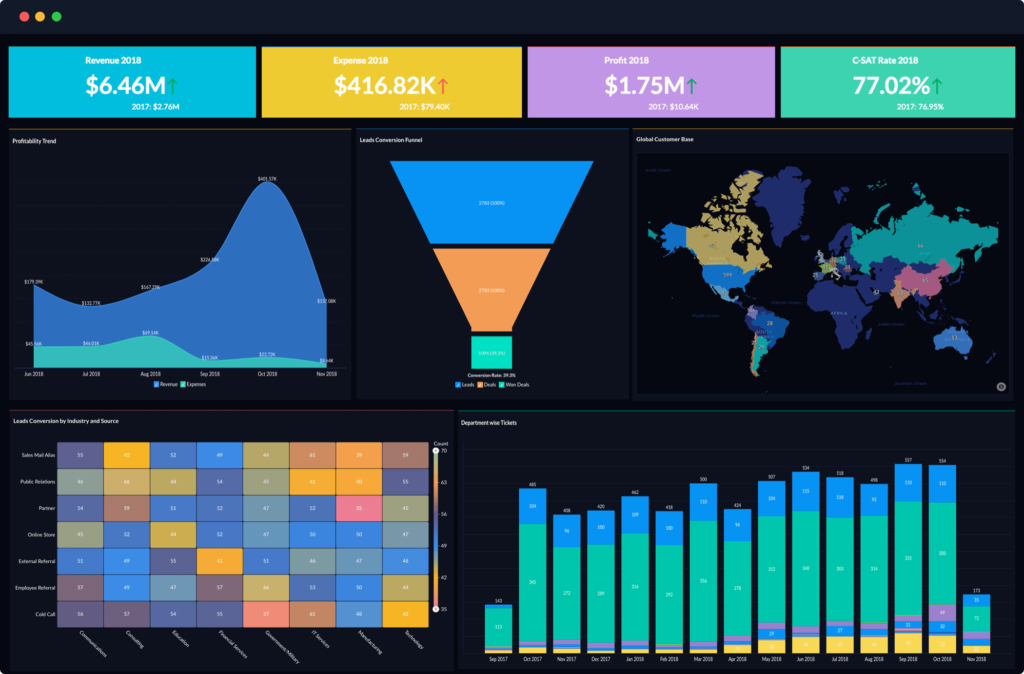Zoho Analytics is a powerful business intelligence suite that empowers business leaders to blend and analyze data from throughout their organizations. Today’s businesses are accumulating a large haystack of data from a broad range of sources, so it is imperative to have a tool, like Zoho Analytics, that can transform raw data into actionable intelligence.

What Is Zoho Analytics?
Zoho Analytics is a tool that helps businesses to make decisions with the data they have in nearly any on-premise system or the cloud. The app makes extensive use of AI to generate data visualizations in a matter of minutes. These visualizations can be viewed within Zoho’s dashboard or exported for use in emails, websites, white-label dashboards, or other media.
Zoho Analytics comes with the functionality to create pivot tables and charts using the conventional approaches that have been used in business for over two decades. However, the app stands out for enabling users to create visualizations by using a natural language assistant named Zia. Therefore, users can simply type “show me revenue by state” to instantly see a breakdown of sales figures in each state.
Integrations are used extensively throughout Zoho Analytics to simplify the utilization of data. The app comes with integrations that support most CRMs, email providers, cloud storage services, and social media platforms. Therefore, you can usually avoid having to do any SQL queries or custom coding to access data with Zoho Analytics. Of course, you can also manually connect data sources if you have the skills to do so.
1. Create Dashboards for Your KPIs
Tracking key performance indicators is an important part of running a successful business in today’s world. When you keep a close eye on KPIs, you can intervene quickly to make changes that will keep your company’s activities aligned with what is necessary for growth and profitability.
With Zoho Analytics, you can create custom dashboards to monitor your KPIs. These dashboards update whenever refreshed, so you can track your KPIs on an up-to-the-minute basis.
Dashboards and reports are a highlight of Zoho Analytics, so they are easy to find and create. Simply click the “Create” button at the top of the app’s interface to start building a dashboard. You can then create a wide range of tables and charts with only a couple of clicks. Once you create a dashboard, share it with colleagues within Zoho’s platform.

Fully customize dashboards to display multiple sets of data. You can keep tabs on several different metrics at the same time within a single dashboard. Also, you can customize dashboards to include charts displaying visualizations of recent data.
When you make full use of dashboards, you can create live reports that are useful for different people within your organization. In a large retail chain, for instance, each department head could create dashboards with KPIs that are relevant to their function within their organization. Store managers could also create dashboards showing the daily performance of their store relative to established KPIs. Therefore, Zoho Analytics can help an entire organization stay focused on achieving targets that add to its bottom line.
2. Use Data From Your CRM
CRM data is powerful because it is usually kept up-to-date and provides the most actionable intelligence about both individual key accounts and aggregate sales performance. If you are currently using Zoho CRM, you can easily integrate Zoho Analytics with this data.
Although Zoho CRM comes with its own reporting functionality, the reporting features in Zoho Analytics are much more robust. You can create live dashboards using your CRM data to display almost any KPIs relevant to your sales process, such as monthly revenue, conversion rate, or even projected revenue.
However, you do not have to only use Zoho’s CRM to utilize your data. Zoho comes with integrations that support CRMs provided by Hubspot, Salesforce, Zendesk, and other major providers. This data can be used to make dashboards that are similar to what you can make with Zoho CRM data.
3. Take Advantage of Embedded Analytics
As mentioned earlier, Zoho Analytics supports the ability to embed live charts, tables, and other dashboard elements into websites. Use these embeds for marketing purposes to show customers or investors data about sales, inquiries, and other relevant metrics. When using them in this way, they can be either live or static depending on the settings that are selected.
Zoho Analytics also has a white-label dashboard allowing users to share data with stakeholders. This dashboard is fully customizable to include your company’s logo and likeness for a seamless experience. The white-label dashboard also supports secure sign-on features, so you can keep away the prying eyes of the general public and competitors.
Taking advantage of the embedded analytics features Zoho offers can enable you to share data in a way that is highly effective and convenient for all parties. Therefore, you can save time when reporting data to third parties while also looking more professional. When data is easy to share, you can make use of it more frequently to improve how you communicate with customers, investors, contractors, and your community as a whole.
4. Use Group Sharing
Collaboration has been proven to be one of the keys to improving performance in the workplace. The ability to share content with other people is one of Zoho’s most important features. Unfortunately, many people who use Zoho fail to take full advantage of its group sharing functionality. Group sharing allows users to make data-driven conversations a daily reality.

Any charts, tables, reports, or other features of Zoho Analytics can be shared by clicking the social sharing icon on the top-right corner of Zoho’s dashboard. You can then list out the email addresses of the people in your organization with whom you would like to share your data.
Once people have viewed your data, they can comment on the data through the Zoho Analytics platform. The ability to leave comments is powerful because this feature helps to facilitate quick collaboration that is highly effective. People who are knowledgeable about an issue can leave a quick one-line comment providing insights or ideas for future opportunities.
5. Deploy Zoho Analytics Across All Departments
Many people who turn to Zoho Analytics have a strong background in tech, sales, or digital marketing. However, the insights Zoho Analytics can provide are equally useful for other departments that normally lag behind in data-driven decision-making.
Your company should strive to teach all decision-makers about how to use Zoho Analytics to profile their performance and recognize opportunities. For instance, HR managers can use Zoho’s business intelligence platform to monitor the number of resume submissions. As well as, the percentage of successful interviews, the average number of weeks employees stay on the job after being hired, and more. Monitoring this data over time can lead to the discovery of new ideas for improvement and the ability to prove whether an implemented change led to worthwhile performance improvements.
Making the Most Out of Zoho Analytics
Zoho Analytics is a robust tool that can help any organization to improve the utilization of data across all sources. The key to getting the most out of Zoho Analytics is to get decision-makers on board with using it in their daily routines. When data is used to guide decisions and supervise performance, dramatic leaps in productivity can be achieved.
Learning to get the most out of Zoho Analytics takes time. But Zoho offers extensive documentation to help decision-makers learn to use it to maximum advantage. Conduct your own research online to learn how Zoho Analytics can enhance your effectiveness in data-driven collaboration, management, and decision-making.









